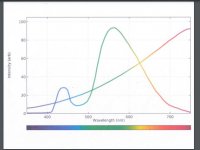Just cause its the best weve tried doesnt mean its the best that can be had. There is a roughness (or maybe fiberyness, if thats even a word) to outdoor grown bud that people dont seem to like. I dont mind it as long as the smoke is great.was it ever an issue that the sun was the best source of light???
And im not convinced i like greenhouse grown bud as much as some of the more deluxe indoor grown bud. The prices on the market also speak against this being as simplistic as sun=best.
But its seems clear to me that standard HE spectrum, 4K+ 660, does not always given you great results. Good, but not great.
I tinker a lot supplementing white led with monos and i have had varied results, mostly good but ive had a lot of problems improving quality of HE spectrum. UVA/UVB/Far red hasnt really changed the dial on quality. I think its down to too much green. But with less green in my base white ive seen good improvements adding reds, uva and far red.
Ymmv




